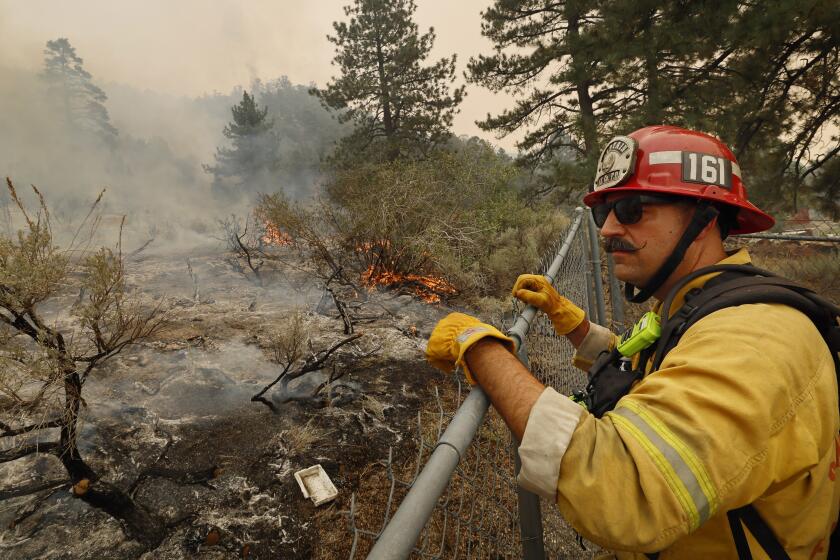County Failed to Notify Air Quality District of Asbestos Removal
Los Angeles County officials who recently removed asbestos from the old San Fernando Courthouse during renovations there apparently violated the federal Clean Air Act by failing to notify the agency that should oversee work to ensure that the deadly fibers were handled properly.
According to federal law, the South Coast Air Quality Management District must be alerted about any construction work that will disturb a relatively large quantity of asbestos so the district can monitor the project and guarantee that workers are following strict rules governing asbestos abatement.
But air quality district officials said they did not receive notification of remodeling at the courthouse. County officials say the project included removing significant amounts of asbestos ceiling plaster and insulation.
County officials claim that they did not know about the notification requirement, which has been in place for more than five years.
Oversaw Project
Brian Richards, who has been overseeing the renovation project for the county Department of Internal Services, said he thought the work, which took place over eight days in April, two days in May, and 15 days in June, was carried out in compliance with all state and federal legal standards.
The courthouse renovations will transform space previously occupied by lawyers’ offices and a branch of the county library into two new courtrooms needed to alleviate overcrowding.
Although it is unlikely that an investigation now can detect whether the asbestos removal was conducted properly, an AQMD official said he will send an investigator to the old courthouse this week.
By the late 1960s, when researchers proved that airborne asbestos fibers can scar the lungs and cause cancer, asbestos had been used for decades in fireproofing, insulation and other building materials. Now, during remodeling, contractors commonly remove any asbestos their work disturbs.
The federal Clean Air Act established as law the procedures that must be followed to prevent the fibers from entering the air. Asbestos must be kept wet and gently removed, lowered to the ground and put into sealed containers for disposal by trained workers who wear protective clothing. It is the AQMD that is responsible for ensuring that these operations are carried out correctly.
But AQMD officials say many contractors do not notify them because they prefer to break the notification law, which carries only a $1,000 fine, rather than risk having their work practices scrutinized.
Careful asbestos removal is an expensive process. In the same way that tough hazardous waste rules have spawned “midnight dumpings,” some contractors have turned to “midnight scrapings”-- trying to do the job without attracting attention, experts said.
Under Fire
However, officials of the county, which has repeatedly come under fire for allowing its workers to be exposed to asbestos in its buildings, denied that they intended to skirt supervision by not telling the AQMD about the asbestos removal.
One thousand square feet of asbestos ceiling plaster and 50 linear feet of asbestos insulation were removed by trained county workers, Richards said. He said the asbestos was taken from a part of the building that was sealed off from the rest of the courthouse--where judges, lawyers and criminal defendants were continuing with their court business in three municipal courtrooms.
Air samples taken before and after the work revealed that the amount of asbestos in the air was within acceptable levels, Richards said.
Roger Desrosiers, who was referred to as the Internal Services Department’s asbestos expert, also denied that the county was trying to escape supervision. “I am not aware that we are required to notify the AQMD,” he said.
Might Not Visit
Even if the AQMD had been notified, inspectors might never have visited the building site because of manpower constraints, said Paul Aunchman, head of the hazardous materials unit of the AQMD’s enforcement division.
However, contractors are typically more careful if they are working under the assumption that they could be inspected at any time, Aunchman said.
If an inspection reveals that an asbestos emission occurred during the removal, the county could be fined $25,000 for each day of asbestos work, said Diana Love, chief prosecutor for the air district.
Even if the inspection does not yield evidence that the asbestos was removed unsafely, the county can still be fined $1,000 for failing to notify the AQMD, she said.
This is not the first time the county has faced disciplinary action for its management of asbestos problems. Last fall, Dist. Atty. Ira Reiner considered pressing criminal charges on behalf of county workers exposed to asbestos. County maintenance workers have complained for years that they are regularly exposed to dust that they believe may contain asbestos fibers. Then state investigators discovered small piles of asbestos debris in crawl spaces between all floors of the downtown Criminal Courts Building.
Also, county employees said they were outraged that officials did nothing for more than six months after a state Department of Health Services study in the spring of 1988 found that 20 county buildings had deteriorating asbestos materials so potentially dangerous that health officials said they should be removed immediately.
More to Read
Sign up for Essential California
The most important California stories and recommendations in your inbox every morning.
You may occasionally receive promotional content from the Los Angeles Times.










